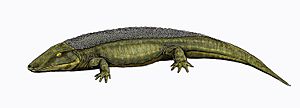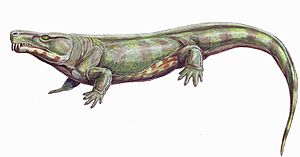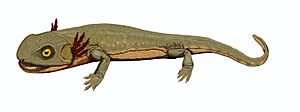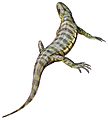Reptiliomorpha facts for kids
Quick facts for kids Reptiliomorphs |
|
|---|---|
 |
|
| Scientific classification | |
| Kingdom: | |
| Phylum: | |
| Class: | |
| Order: |
Reptiliomorpha
|
|
|
Reptiliomorpha is a group of ancient animals that are closely related to amniotes. Amniotes are a big group that includes reptiles, birds, and mammals (like us!). So, Reptiliomorphs are like the ancestors of all these animals. They were also related to tetrapods, which are animals with four limbs.
Sometimes, different scientists use the name "Reptiliomorpha" in slightly different ways. But it's best to think of them as animals that laid special eggs called cleidoic eggs. These eggs were a big step towards living fully on land.
Contents
What Made Them Special?
Reptiliomorphs were a mix of amphibian and reptile features. They were often called "reptile-like amphibians." Some, like the gephyrostegids, seymouriamorphs, and diadectomorphs, lived mostly on land. Others, like the embolomeres, lived in water and had long bodies with short legs.
Scientists look at a few key things to identify Reptiliomorphs:
- Their upper jaw bones (called premaxillae) were narrow.
- Bones in the roof of their mouth (called vomers) got narrower towards the front.
- The number of joints in their toes (called phalangeal formulae) followed a specific pattern: 2.3.4.5.4–5.
Their Heads
Reptiliomorphs had deeper and taller skulls compared to other amphibians of their time. This allowed their eyes to be placed on the sides of their heads, instead of on top like many amphibians. Their skulls often had cool, wavy patterns. They also had a deep notch at the back of their skull, which might have held a spiracle (a small breathing hole) instead of an eardrum.
Their Bodies
Their backbones (or vertebrae) were made of several parts, similar to other ancient amphibians. Over time, the main part of their backbone became stronger, which was a step towards how backbones are formed in reptiles and mammals.
Unlike many amphibians, Reptiliomorphs had bodies that were moderately deep, not flat. Their limbs were strong and well-formed. This shows that most of them lived on land, even though some groups later went back to living in water. Each foot had five toes, just like their reptile and mammal descendants. However, their ankle bones were not quite like those of true reptiles.
How They Lived
Reptiliomorphs were generally heavy-bodied, much like early reptiles. Their skin probably had a tough, waterproof outer layer, similar to modern reptiles. This helped them stay hydrated on land. Some, like the chroniosuchians, even had bumpy or scaly skin.
We know that some seymouriamorphs, like Discosauriscus, reproduced like amphibians. They laid their eggs in water, and the eggs hatched into larvae (like tadpoles) with outside gills. We don't know for sure how all other Reptiliomorphs reproduced.
How They Evolved
Early Reptiliomorphs
During the Carboniferous and Permian periods, some tetrapods began to change, becoming more like reptiles. Some, like Archeria, were long and eel-like, living in water with tiny limbs. Others, like Seymouria and Diadectes, looked so much like reptiles that scientists used to think they *were* true reptiles! To us, they might have looked like large, sturdy lizards.
Some groups, like the chroniosuchians, were similar to modern crocodiles. They were likely predators living by rivers. The two groups most adapted to land were the Seymouriamorpha, which ate insects or meat, and the Diadectomorpha, which were mostly plant-eaters and often quite large. The Diadectomorpha are thought to be the closest relatives to the first amniotes.
From Water Eggs to Land Eggs
Living on land was great, but these animals still had to go back to water to lay their eggs. Their eggs would hatch into larvae that needed water to grow. This made them want to find a way to lay eggs on land. Maybe it was to avoid competition for ponds, or to live in drier places, or to protect their young from fish.
This led to a big change: internal fertilization (eggs fertilized inside the body) and direct development. This means the tadpole stage happened inside the egg, so the baby hatched looking like a miniature adult.

The biggest step was the development of the amniote egg. This amazing egg has special membranes that protect the embryo and help it breathe. One membrane, the allantois, holds the embryo's waste, stopping it from getting poisoned. Another, the amnion, surrounds the baby itself. And the chorion wraps around everything. These membranes allowed the egg to survive and develop fully on land, without needing water.
Where Amniotes Came From
It's hard to say exactly when the first true amniotes appeared because their soft egg structures don't fossilize well. However, some small, advanced Reptiliomorphs like Solenodonsaurus, Casineria, and Westlothiana might have been among the very first amniotes. These small animals would have laid small eggs, which could develop on land more easily.

Even after amniotes appeared, non-amniote Reptiliomorphs continued to live for millions of years. By the middle Permian period, most land-dwelling non-amniote forms had died out. But some water-dwelling groups, like the chroniosuchians, survived even the huge mass extinction at the end of the Permian. They finally died out before the end of the Triassic period. Meanwhile, the amniotes, the successful descendants of Reptiliomorphs, kept growing and evolving into all the amazing mammals, reptiles, and birds we see today!
Images for kids
-
Diplocaulus, a diplocaulid "nectridean"
-
Casineria, an amniote-like reptiliomorph
See also
 In Spanish: Reptiliomorpha para niños
In Spanish: Reptiliomorpha para niños















